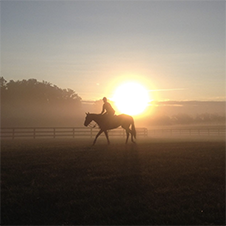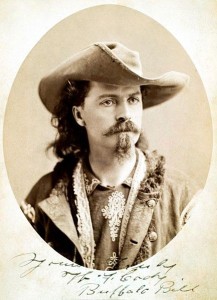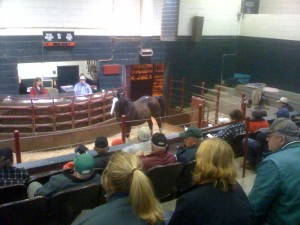Buffalo Bill and Will Rogers
Buffalo Bill might be one of the earliest examples of an entertainment entrepreneur.
Bill Cody had many western-related jobs during his early career in the 1860s and 1870s; these included army scout, buffalo hunter, and pony express rider. But Cody is better known for the show he established, Buffalo Bill’s Wild West (1883 – early 1900s) which took the “wild west” to audiences throughout America and Europe.
Buffalo Bill’s Wild West show undertook 33 tours, which included the Chicago World’s Fair in the United States, and 8 tours in Europe; the European tours began with the American Exhibition in London, in 1887, performing in front of Queen Victoria.
The show clearly had an impact, in both Europe and America, and influenced many 20th-century portrayals of “the West” in the emerging media landscape. The show also included a cast of characters that comprised other western luminaries such as Sitting Bull, Annie Oakley and Calamity Jane.
Buffalo Bill became an international celebrity in his own right, as he shared with his audiences something that was distinctly American.
Will Rogers was perhaps the first “western” personality who truly understood the emerging media of his time, movies, newspapers and later, radio.
Rogers’ entertainment career began as a vaudeville rope act, bringing his “western” tricks to the New York City theater audience. Rogers combined his western show with commentary of the news of the day.
He was able to branch out and wrote more than 4,000 nationally syndicated newspaper columns, an extension of his news commentary. His silent movie career began while he was still in New York, before he then relocated to California. In total, Rogers made 71 movies, of which 50 were silent, and 21 were “talkies”. Rogers was a leading earning movie star during the 1930s. As the radio medium developed in the latter part of the 1920s, Rogers became a radio personality too.
Buffalo Bill Cody and Will Rogers had done much to establish the western culture in the psyche of America and abroad.
The Western Movie
As the movie industry developed in the early 1920s, western movies became a very popular genre. These movies portrayed and sometimes glamorized the frontier life of the cowboy, the indian, the army, and the spectacular vistas. Of course, an important element of frontier life, and by default, the western movie, is the horse.
The horse was sometimes central to the story, but always participated. In some of the early western movies horses received star billing, alongside co-stars such as William Hart (Fritz), Tom Mix (Tony), ken Maynard (Tarzan), Gene Autry (Champion) and Roy Rogers (Trigger).
Horses have remained an important element of a plot in both movies and books. Fictional examples include Black Beauty, National Velvet, War Horse, The Black Stallion and Flicka.
Television
Television, the final broadcast medium to emerge, in the 1950s, included a variety of early shows that focused on horses and the western culture. These shows included the Lone Ranger (and Silver), which evolved from the radio medium and also spawned a series of books, Champion the Wonder Horse, a 1950s TV series, and Mr Ed, which ran from 1961-1966.
Horse Racing
Horses have also appeared in media as a result of horse racing.
Seabiscuit, who raced from 1935 to 1940, became a best-selling book by Laura Hillenbrand, as well as a terrific movie, in the early 2000s. Other race horses, like Triple Crown winning Secretariat have also inspired multiple books and movies.
Horses and the western culture, have been important to the rise of media, and media has been crucial in establishing the western culture, and horses, as part of the American culture.
If I have overlooked an important event, horse or character, please include this in the comments.


